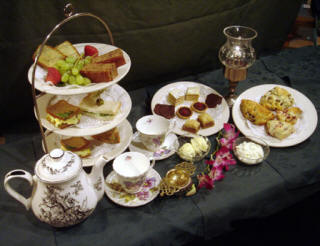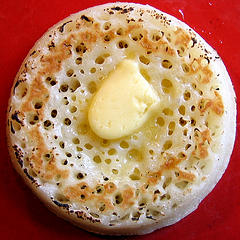|
Dinner is, for most
English speakers, the main meal of the day. When the word was first used
(in the 12th century) it referred to a midday meal, but it
did not remain so for long. By the early 16th century it had
become the first meal of the day, what we would call breakfast. No doubt
those 16th century diners had their own reasons for this but
it makes perfect sense etymologically as the verb to dine comes
from the Late Latin
disjejunare,
“to breakfast” via the Old French disner. The Latin word
disjejunare, incidentally, is quite literally “break fast”, being
dis (“undo”) + jejunare (“to fast”) and also gave the French
word déjeuner "breakfast"*. Obviously, dinner could not
get any earlier than breakfast and after the
16th century it drifted through the day,
being served later and later until, during the Victorian era, high
society sat down to dinner at 10 p.m. Having one’s main meal of the day
at such a late hour meant that many tummies were growling by late
afternoon. To avoid that unpleasant hollow feeling, a new meal was
invented. It was just a light snack, basically a few cakes and pastries
served with the expensive new status symbol, tea. Consequently, the meal
was called “tea”.
The name used for
this drink tells a lot about how the word entered a language. Like
French, Spanish, Italian, Dutch, German, Danish and Swedish (thé,
te, tè, thee, thee, te andte,
respectively)
we acquired the name from Malay traders who called it te, a word
they learned from the Amoy dialect of Chinese. The Portuguese, who call
it cha, traded with Chinese who spoke the Mandarin dialect, in
which it is called ch’a.
Throughout the
Middle East and India, the word is usually chai or some variant
thereof. This is also the Russian word as tea reached Russia overland,
via the Silk Road. In India, tea is brewed with milk and a mixture of
spices called chai masala (Hindi for “tea spice”). This
concoction is known as masala chai (Hindi, “spiced tea”) or
simply as chai. As a result, the word chai has now entered
the English language and it is not uncommon to see coffee bars offering
something called chai tea (literally “tea tea”).
Spanish, Italian, Dutch, German, Danish and Swedish (thé,
te, tè, thee, thee, te andte,
respectively)
we acquired the name from Malay traders who called it te, a word
they learned from the Amoy dialect of Chinese. The Portuguese, who call
it cha, traded with Chinese who spoke the Mandarin dialect, in
which it is called ch’a.
Throughout the
Middle East and India, the word is usually chai or some variant
thereof. This is also the Russian word as tea reached Russia overland,
via the Silk Road. In India, tea is brewed with milk and a mixture of
spices called chai masala (Hindi for “tea spice”). This
concoction is known as masala chai (Hindi, “spiced tea”) or
simply as chai. As a result, the word chai has now entered
the English language and it is not uncommon to see coffee bars offering
something called chai tea (literally “tea tea”).
 Many
U.S. tea-shops offer something called high tea - usually a fancy
affair with varietal teas, crustless cucumber sandwiches and dainty
pastries, and a high price. It is our experience that these tea-shops
invariably think they are providing an opportunity to sample an English
tradition. They are not. This is not to say that the English don’t treat
themselves to fine teas, crumpets and scones - far from it. But when
they do they don’t call it high tea. In England high tea
is a distinctly working-class expression which is used in the North of
England to mean “dinner” and is synonymous with meat tea - tea
with which meat is served. High tea is the main, cooked meal of
the day, served in the early evening. Thus, fish and chips would qualify
as high tea whether or not a pot of tea appears on the table.
We would like to introduce Americans to the term cream tea, which
is what the British call tea served with crumpets, muffins, scones, jam
and clotted cream, though the earliest recorded instance of this term
comes from only 1964, at least so far! Many
U.S. tea-shops offer something called high tea - usually a fancy
affair with varietal teas, crustless cucumber sandwiches and dainty
pastries, and a high price. It is our experience that these tea-shops
invariably think they are providing an opportunity to sample an English
tradition. They are not. This is not to say that the English don’t treat
themselves to fine teas, crumpets and scones - far from it. But when
they do they don’t call it high tea. In England high tea
is a distinctly working-class expression which is used in the North of
England to mean “dinner” and is synonymous with meat tea - tea
with which meat is served. High tea is the main, cooked meal of
the day, served in the early evening. Thus, fish and chips would qualify
as high tea whether or not a pot of tea appears on the table.
We would like to introduce Americans to the term cream tea, which
is what the British call tea served with crumpets, muffins, scones, jam
and clotted cream, though the earliest recorded instance of this term
comes from only 1964, at least so far!
But what about all those
crumpets, muffins and scones? A crumpet is a round, flat bread with many holes on its upper surface. The word crumpet first appears
in the 14th century in the expression a crompid cake.
Crompid here means “curled up” (just like cruller, by the
way) which suggests that the original crompids were somewhat different
from our crumpets. In the Midlands and West of England you might hear
crumpets called pikelets. This is one of the very few instances
of the English language borrowing a word from Welsh. The original is
bara pyglyd (Welsh for “pitchy bread”, presumably from its color).
The origin of muffin is not nearly as clear-cut but it is
believed to be related to the Old French
moufflet,
“soft”. In recent years, scones have become popular in the U.S. though
they have rapidly diverged from their English origins. Large, triangular
and filled with fruit, they are a far cry from the small, round plain
scones which demand to be slathered with Devonshire clotted cream and
jam. Also, the American version of the scone rhymes with “bone” whereas
the English kind (usually) rhymes with “gone”. The word scone is
believed to be an abbreviation of the Middle Dutch
schoonbrot or the
Middle Low
German schonbrot, both
of which mean “fine bread”.
many holes on its upper surface. The word crumpet first appears
in the 14th century in the expression a crompid cake.
Crompid here means “curled up” (just like cruller, by the
way) which suggests that the original crompids were somewhat different
from our crumpets. In the Midlands and West of England you might hear
crumpets called pikelets. This is one of the very few instances
of the English language borrowing a word from Welsh. The original is
bara pyglyd (Welsh for “pitchy bread”, presumably from its color).
The origin of muffin is not nearly as clear-cut but it is
believed to be related to the Old French
moufflet,
“soft”. In recent years, scones have become popular in the U.S. though
they have rapidly diverged from their English origins. Large, triangular
and filled with fruit, they are a far cry from the small, round plain
scones which demand to be slathered with Devonshire clotted cream and
jam. Also, the American version of the scone rhymes with “bone” whereas
the English kind (usually) rhymes with “gone”. The word scone is
believed to be an abbreviation of the Middle Dutch
schoonbrot or the
Middle Low
German schonbrot, both
of which mean “fine bread”.
Well, we have to dash now, it’s almost tea-time.
But just when is that, exactly? In case you think this question is too
easy, we should point out that in Jamaica tea is the name given
to breakfast.*Jejunare
also gave us jejunum, the "fasting" portion of the gut, so named
as digested material does not remain there. Jejune comes
from the Latin verb, also, and originally had the meaning, in English,
of "without food, fasting, hungry" (early 17th c.), and then
"undernourished" (mid-17th c.), but there was also "unsatisfying, poor,
barren" (early 17th c.), and then "puerile, childish" (19th c.; this
meaning is thought to derive from the misconception that jejune
is related to French jeune "young"). |